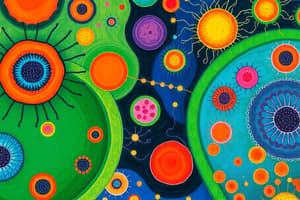Podcast
Questions and Answers
Which of the following characteristics is LEAST likely to be found in the last common ancestor of all living eukaryotes?
Which of the following characteristics is LEAST likely to be found in the last common ancestor of all living eukaryotes?
- Descendant of a chimera-like organism
- Presence of a complex cell structure
- Ability to form symbiotic relationships (correct)
- Cell size of 10 µm or greater
The fossil record provides a complete and detailed account of the evolutionary events leading to the last common ancestor of extant eukaryotes.
The fossil record provides a complete and detailed account of the evolutionary events leading to the last common ancestor of extant eukaryotes.
False (B)
What is the name given to the major theme in the origin of eukaryotes, describing one cell engulfing another?
What is the name given to the major theme in the origin of eukaryotes, describing one cell engulfing another?
Endosymbiosis
Organisms are currently classified into three domains: Archaea, Bacteria, and ______.
Organisms are currently classified into three domains: Archaea, Bacteria, and ______.
Match the domain with the cell type it contains:
Match the domain with the cell type it contains:
The earliest fossils are those of domain Bacteria and are how old?
The earliest fossils are those of domain Bacteria and are how old?
The structure of living eukaryotic cells suggests that interactions among prokaryotes gave rise to the eukaryotes.
The structure of living eukaryotic cells suggests that interactions among prokaryotes gave rise to the eukaryotes.
What is the approximate cell size, in µm, of most living eukaryotes?
What is the approximate cell size, in µm, of most living eukaryotes?
Which of the following is the most accurate description of secondary endosymbiosis?
Which of the following is the most accurate description of secondary endosymbiosis?
Plastids, similar to mitochondria, can be synthesized de novo (from scratch) within the host cell.
Plastids, similar to mitochondria, can be synthesized de novo (from scratch) within the host cell.
What is the name given to the vestigial nucleus found in some secondary plastids?
What is the name given to the vestigial nucleus found in some secondary plastids?
In glaucophytes and Paulinella, a thin layer of ______ is present between the outer and inner plastid membranes.
In glaucophytes and Paulinella, a thin layer of ______ is present between the outer and inner plastid membranes.
Match the following algae groups with their endosymbiotic origin:
Match the following algae groups with their endosymbiotic origin:
What characteristic distinguishes plastids formed through secondary endosymbiosis from those formed through primary endosymbiosis?
What characteristic distinguishes plastids formed through secondary endosymbiosis from those formed through primary endosymbiosis?
The outer membrane of a plastid is believed to be derived from the plasma membrane of the original cyanobacterial endosymbiont.
The outer membrane of a plastid is believed to be derived from the plasma membrane of the original cyanobacterial endosymbiont.
In chlorarachniophytes, how many membranes surround the plastids, and what is the origin of each membrane?
In chlorarachniophytes, how many membranes surround the plastids, and what is the origin of each membrane?
The Archaeplastida clade is believed to have originated from an endosymbiotic event occurring approximately ______ years ago.
The Archaeplastida clade is believed to have originated from an endosymbiotic event occurring approximately ______ years ago.
What is the ultimate fate of genes from the endosymbiont during the process of endosymbiosis?
What is the ultimate fate of genes from the endosymbiont during the process of endosymbiosis?
Which of the following metabolic processes is notably absent in eukaryotes but present in prokaryotes?
Which of the following metabolic processes is notably absent in eukaryotes but present in prokaryotes?
The Earth's early atmosphere was rich in molecular oxygen (O2), facilitating the early evolution of aerobic respiration.
The Earth's early atmosphere was rich in molecular oxygen (O2), facilitating the early evolution of aerobic respiration.
What waste product was released when cyanobacteria used water as a hydrogen source during photosynthesis?
What waste product was released when cyanobacteria used water as a hydrogen source during photosynthesis?
According to the endosymbiotic theory, eukaryotes may have evolved when one cell engulfed another, leading to a mutualistic metabolic pathway to produce ______.
According to the endosymbiotic theory, eukaryotes may have evolved when one cell engulfed another, leading to a mutualistic metabolic pathway to produce ______.
Match the following bacterial groups with their characteristics:
Match the following bacterial groups with their characteristics:
Lynn Margulis is best known for her work on which theory?
Lynn Margulis is best known for her work on which theory?
Mitochondria can survive and reproduce independently outside of the cell.
Mitochondria can survive and reproduce independently outside of the cell.
What is believed to be the source of the nuclear genes and molecular machinery responsible for replication and expression in eukaryotes?
What is believed to be the source of the nuclear genes and molecular machinery responsible for replication and expression in eukaryotes?
Mitochondria possess their own genomes with a ______ chromosome stabilized by attachments to the inner membrane.
Mitochondria possess their own genomes with a ______ chromosome stabilized by attachments to the inner membrane.
Which of the following is a characteristic feature of mitochondria that supports the endosymbiotic theory?
Which of the following is a characteristic feature of mitochondria that supports the endosymbiotic theory?
What is the primary function of mitochondria within eukaryotic cells?
What is the primary function of mitochondria within eukaryotic cells?
The endosymbiotic event that led to the development of mitochondria is confirmed to have occurred after the host cell developed a nucleus.
The endosymbiotic event that led to the development of mitochondria is confirmed to have occurred after the host cell developed a nucleus.
Approximately when did oxygen levels in the atmosphere reach levels similar to today's concentrations?
Approximately when did oxygen levels in the atmosphere reach levels similar to today's concentrations?
The process of ______ is localized in the mitochondria and is found in all major lineages of eukaryotes.
The process of ______ is localized in the mitochondria and is found in all major lineages of eukaryotes.
Match each term relating to the endosymbiotic theory with its description:
Match each term relating to the endosymbiotic theory with its description:
What key structural feature of mitochondria supports the endosymbiotic theory?
What key structural feature of mitochondria supports the endosymbiotic theory?
Mitochondria can be formed from scratch (de novo) by eukaryotic cells when needed.
Mitochondria can be formed from scratch (de novo) by eukaryotic cells when needed.
What is the name given to the infoldings of the inner mitochondrial membrane, which are rich in enzymes necessary for aerobic respiration?
What is the name given to the infoldings of the inner mitochondrial membrane, which are rich in enzymes necessary for aerobic respiration?
Like mitochondria, plastids are believed to have originated from a process called __________.
Like mitochondria, plastids are believed to have originated from a process called __________.
Match the following organelles with their likely prokaryotic ancestor:
Match the following organelles with their likely prokaryotic ancestor:
What is the primary function of accessory pigments found in chloroplasts?
What is the primary function of accessory pigments found in chloroplasts?
Gene transfer from endosymbiont chromosomes to the host genome may explain why mitochondria cannot live without a host.
Gene transfer from endosymbiont chromosomes to the host genome may explain why mitochondria cannot live without a host.
What type of bacteria are plastids derived from?
What type of bacteria are plastids derived from?
The outer mitochondrial membrane is believed to be derived from the __________ of the host cell during endosymbiosis.
The outer mitochondrial membrane is believed to be derived from the __________ of the host cell during endosymbiosis.
What is a key function of mitochondria, other than ATP production?
What is a key function of mitochondria, other than ATP production?
All eukaryotic cells contain mitochondria.
All eukaryotic cells contain mitochondria.
By what process do mitochondria divide?
By what process do mitochondria divide?
Photosynthetic plastids are called __________.
Photosynthetic plastids are called __________.
What structural feature do chloroplasts of primary origin possess?
What structural feature do chloroplasts of primary origin possess?
The acquisition of cyanobacterial endosymbionts happened only once in the history of eukaryotes.
The acquisition of cyanobacterial endosymbionts happened only once in the history of eukaryotes.
Flashcards
Three Domains of Life
Three Domains of Life
The three broad classifications of life: Archaea, Bacteria, and Eukarya.
Prokaryotic Cells
Prokaryotic Cells
Cells without a nucleus or other membrane-bound organelles; includes Bacteria and Archaea.
Eukaryotic Cells
Eukaryotic Cells
Cells with a nucleus and other membrane-bound organelles; belong to the Eukarya domain.
Stromatolites
Stromatolites
Signup and view all the flashcards
Eukaryotic Common Ancestry
Eukaryotic Common Ancestry
Signup and view all the flashcards
Endosymbiosis
Endosymbiosis
Signup and view all the flashcards
Chimera-like organism
Chimera-like organism
Signup and view all the flashcards
Origin of Mitochondria
Origin of Mitochondria
Signup and view all the flashcards
Endosymbiotic Theory
Endosymbiotic Theory
Signup and view all the flashcards
Mitochondria
Mitochondria
Signup and view all the flashcards
Aerobic Respiration
Aerobic Respiration
Signup and view all the flashcards
Mitochondria in Eukaryotes
Mitochondria in Eukaryotes
Signup and view all the flashcards
Cyanobacteria
Cyanobacteria
Signup and view all the flashcards
Aerobic Respiration's Benefit
Aerobic Respiration's Benefit
Signup and view all the flashcards
Photosynthesis
Photosynthesis
Signup and view all the flashcards
Nitrogen Fixation
Nitrogen Fixation
Signup and view all the flashcards
Alpha-proteobacteria
Alpha-proteobacteria
Signup and view all the flashcards
Mitochondrial Genomes
Mitochondrial Genomes
Signup and view all the flashcards
Mitochondrion
Mitochondrion
Signup and view all the flashcards
Rise of Eukaryotes
Rise of Eukaryotes
Signup and view all the flashcards
Photosynthesis
Photosynthesis
Signup and view all the flashcards
Mitochondria function
Mitochondria function
Signup and view all the flashcards
Secondary Endosymbiosis
Secondary Endosymbiosis
Signup and view all the flashcards
Nucleomorph
Nucleomorph
Signup and view all the flashcards
Primary Endosymbiosis
Primary Endosymbiosis
Signup and view all the flashcards
Chlorarachniophytes
Chlorarachniophytes
Signup and view all the flashcards
Three or More Membranes
Three or More Membranes
Signup and view all the flashcards
Euglenids
Euglenids
Signup and view all the flashcards
Dinoflagellates, Apicomplexans, and Stramenopiles
Dinoflagellates, Apicomplexans, and Stramenopiles
Signup and view all the flashcards
Host Vacuole Derivation
Host Vacuole Derivation
Signup and view all the flashcards
Cyanobacterial Plasma Membrane Derivation
Cyanobacterial Plasma Membrane Derivation
Signup and view all the flashcards
Glaucophytes
Glaucophytes
Signup and view all the flashcards
Endosymbiotic Theory (Mitochondria)
Endosymbiotic Theory (Mitochondria)
Signup and view all the flashcards
Gene Transfer (Mitochondria)
Gene Transfer (Mitochondria)
Signup and view all the flashcards
Cristae
Cristae
Signup and view all the flashcards
Mitochondrial Reproduction
Mitochondrial Reproduction
Signup and view all the flashcards
Plastids
Plastids
Signup and view all the flashcards
Chloroplasts
Chloroplasts
Signup and view all the flashcards
Endosymbiotic Theory (Plastids)
Endosymbiotic Theory (Plastids)
Signup and view all the flashcards
Thylakoids
Thylakoids
Signup and view all the flashcards
Accessory Pigments
Accessory Pigments
Signup and view all the flashcards
Mitochondrial Membranes
Mitochondrial Membranes
Signup and view all the flashcards
Cristae Structure Analogy
Cristae Structure Analogy
Signup and view all the flashcards
Mitochondrial Metabolic Functions
Mitochondrial Metabolic Functions
Signup and view all the flashcards
Study Notes
- Organisms are classified into three domains: Archaea, Bacteria, and Eukarya.
- Archaea and Bacteria include all prokaryotic cells, while Eukarya contains all eukaryotes.
Fossil Record
- A sparse fossil record makes it difficult to determine the appearance of the first members of each lineage.
- The earliest fossils found belong to domain Bacteria, dating back 3.5 to 3.8 billion years.
- Fossil stromatolites suggest some prokaryotes lived in interactive communities.
- Structures resembling fossilized remains of early eukaryotes appear in geological deposits dating to about 2.1 billion years ago.
- Comparative biology and the fossil record offer insights into the evolution of Eukarya.
- Living eukaryotes are descendants of a single common ancestor.
Endosymbiosis
- All extant eukaryotes are likely the descendants of a chimera-like organism.
- The chimeric organism was a composite of a host cell and an alpha-proteobacterium.
- Endosymbiosis is a major theme in the origin of eukaryotes, where one cell engulfs another.
- The engulfed cell survives within the host and both benefit.
- Endosymbiotic events contributed to the origin of the last common ancestor of today's eukaryotes and later diversification.
Metabolic Processes
- Many important metabolic processes arose in prokaryotes, but some, like nitrogen fixation, are not found in eukaryotes.
- Aerobic respiration, localized in the mitochondria, is present in all major lineages of eukaryotes.
- Molecular oxygen (O2) was originally lacking in the Earth's atmosphere.
- Some prokaryotes evolved the ability to photosynthesize between 3.2 and 3.5 billion years ago.
- Cyanobacteria used water as a hydrogen source and released O2 as a waste product around 2.2 billion years ago.
- Aerobic respiration allowed organisms to thrive in oxygen-rich environments and generate high levels of ATP.
Mitochondria
- Observed in the late 1800s as worm-shaped structures moving in the cell.
- Lynn Margulis developed the endosymbiotic theory, stating eukaryotes were produced from one cell engulfing another.
- The engulfed cell lives within another and coevolves over time.
- Mitochondria are the organelles responsible for producing ATP using aerobic respiration.
- Nuclear genes and molecular machinery for replication and expression are closely related to those in Archaea.
- Eukaryotic cells have from one to thousands of mitochondria, being most abundant in the liver and skeletal muscles in humans.
- Mitochondria cannot survive and reproduce outside the cell.
- Mitochondria have their own genomes, with a circular chromosome stabilized by attachments to the inner membrane, ribosomes, and tRNAs that resemble prokaryotes.
- Genes for respiratory proteins are now relocated in the nucleus.
Mitochondrial Structure
- Shaped like alpha-proteobacteria and have two membranes.
- The outer membrane is eukaryotic.
- The inner membrane is bacterial in nature.
- Mitochondrial inner membrane has infoldings called cristae.
Mitochondrial Reproduction
- Divide independently through a process resembling binary fission in prokaryotes.
- Mitochondria arise only from previous mitochondria rather than being built from scratch.
- They reproduce within their enclosing cell and are distributed with the cytoplasm when a cell divides or two cells fuse.
Anaerobic Eukaryotes
- Some living eukaryotes are anaerobic and cannot survive with too much oxygen.
- Reduced organelles are found in most anaerobic eukaryotes, and virtually all eukaryotes carry some genes in their nuclei that are of mitochondrial origin.
- Mitochondria also generate clusters of iron and sulfur that are important cofactors of many enzymes.
- The protist Monocercomonoides has no mitochondria, derived genes, or related nuclear genes, representing an end-point in mitochondrial reduction.
Plastids
- Some groups of eukaryotes are photosynthetic with cells containing plastids.
- Plastids contain chlorophyll a and accessory pigments for harvesting light energy.
- Photosynthetic plastids are called chloroplasts.
- Plastids have an endosymbiotic origin and are derived from cyanobacteria that lived inside the cells of an ancestral, aerobic, heterotrophic eukaryote.
- Plastids of primary origin are surrounded by two membranes.
Primary Endosymbiosis
- The common ancestor of Archaeplastida took on a cyanobacterial endosymbiont.
- The ancestor of rhizarian taxon Paulinella also took on a cyanobacterial endosymbiont.
Cyanobacteria
- Gram-negative bacteria with internal, membrane-bound sacs called thylakoids.
- Chlorophyll is a component of thylakoid membranes.
- Cyanobacteria have peptidoglycan walls and lipopolysaccharide layers.
- Chloroplasts have thylakoids, circular DNA chromosomes, and ribosomes similar to cyanobacteria.
- Outer membrane is derived from the host’s enclosing vacuole.
- The inner membrane is derived from the plasma membrane of the cyanobacterial endosymbiont.
Plastid Evolution
- In glaucophytes and Paulinella, a thin peptidoglycan layer is still present between the outer and inner plastid membranes.
- Genes of the endosymbiont were transferred to the nucleus.
- Plastids cannot live independently outside the host.
- Plastids come from division of other plastids and are never built from scratch
- Archaeplastida occurred 1 to 1.5 billion years ago.
Secondary Endosymbiosis
- Some groups of algae became photosynthetic by taking in green or red algae as endosymbionts.
- Secondary plastids are surrounded by three or more membranes.
- Some secondary plastids have nucleomorphs of endosymbiotic algae.
- Tertiary or higher-order endosymbiotic events explain the features of some eukaryotic plastids.
Chlorarachniophytes
- Molecular and morphological evidence suggest that chlorarachniophyte protists are derived from a secondary endosymbiotic event.
- Chlorarachniophytes are reticulose amoebae found in tropical seas and sand.
- A eukaryote engulfed a green alga that had an endosymbiotic relationship with a photosynthetic cyanobacterium.
- Chloroplasts in chlorarachniophytes are still capable of photosynthesis.
- The green algal endosymbiont exhibits a vestigial nucleus.
- Plastids of chlorarachniophytes are surrounded by four membranes.
Plastid Membranes
- The first two membranes correspond to the inner and outer membranes of the photosynthetic cyanobacterium.
- The third membrane represents the plasma membrane of the green alga.
- The fourth membrane is the vacuole that surrounded the green alga when engulfed by the chlorarachniophyte ancestor.
- Secondary plastids are also found in the Excavates and the Chromalveolates.
- Secondary endosymbiosis of green algae led to euglenid protists in the Excavates.
- Secondary endosymbiosis of red algae led to the evolution of plastids in dinoflagellates, apicomplexans, and stramenopiles in the Chromalveolates.
Studying That Suits You
Use AI to generate personalized quizzes and flashcards to suit your learning preferences.




